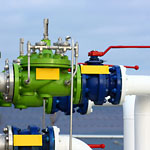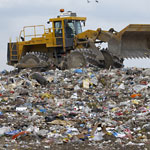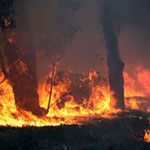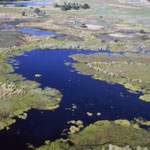| Index | Highlights | Presentation | Contributors | Press & Media | Images |
Methane Budget
Highlights
|
Context |
 |
After carbon dioxide (CO2), methane (CH4) is the second most important well-mixed greenhouse gas contributing to human-induced climate change. In a time horizon of 100 years, CH4 has a Global Warming Potential (GWP-100) 28 times larger than CO2. The level of CH4 in the atmosphere is above 150% from pre-industrial times (cf. 1750), and it is responsible for 20% of the global warming produced by all well-mixed greenhouse gases. Methane is transformed into water vapour in the stratosphere. Methane also produces ozone in the troposphere, which is a pollutant with negative impacts on human health and ecosystems. The atmospheric life time of methane is 10 ± 2 years. |
Global Budget |
|
 |
For the decade of 2000-2009, global emissions of methane are 548 (526-569) Tg CH4 per year as estimated from atmospheric inversions (top-down approach). The global CH4 sink is 540 (514–560) Tg CH4 per year. The source–sink mismatch reflects, and is consistent with, the observed average imbalance in the atmosphere of 6 Tg CH4 per year (the CH4 growth rate). The sum of all sources as estimated from inventories and modeling (bottom-up approaches) is 678 (542-852) Tg CH4, 20% higher than estimated from the top-down approach and reflecting the compounded uncertainties of the multiple CH4 sources. |
|
Trends |
 |
The observed stabilization of atmospheric CH4 between 1999 and 2006 is likely to be due to a reduction in or stabilization of fossil fuel emissions, combined with the stabilization or increase in microbial emissions. After 2006, the renewed global increase in atmospheric CH4 is consistent with higher emissions from wetlands and fossil fuel burning, although the relative contributions remain uncertain. |
|
Anthropogenic Emissions |
 |
Total CH4 emissions from human activities for the decade 2000-2009 are 331 (304-368) Tg CH4 (bottom-up estimates). This amount is equivalent in magnitude as all emissions from natural processes put together. The most important sources are emissions from extracting and processing fossil fuels (26-32%), livestock (26-28%), and landfills/waste (20-27%). Rice cultivation and biomass burning (including the combustion of biomass for biofuels) emit about 10-12% each. |
|
Natural Emissions |
 |
Natural emissions of CH4 are 347 (238-484) Tg CH4 for the decade of 2000-2009 and are dominated by emissions from wetlands (51-82%). Geological sources such as terrestrial and marine seeps and volcanoes account for 10-22%, followed by emissions from freshwater bodies such as kales and river (2-21%). Other smaller sources include ruminant wild animals, termites, hydrates and permafrost. |
|
Sinks |
 |
A number of chemical and biological processes in the atmosphere and soils consume CH4 and therefore are the sinks of CH4. The primary sink is oxidation by hydroxyl radicals (OH), mostly in the troposphere, accounting for about 90% of the global methane sink. Additional sinks include methanotrophic bacteria in aerated soils, reactions with chlorine radicals and atomic oxygen radicals in the stratosphere, and reactions with chlorine radicals from sea salt in the marine boundary layer. Sinks for the 2000-2009 decade are estimated to be 548 (526-569) Tg CH4 per year. |
|
Uncertainties |
 |
For the 2000's, the uncertainty range for bottom-up estimates — defined as (max−min)/mean — is 50% for natural wetlands and typically 100% for other smaller natural sources. Anthropogenic sources are better known, with an uncertainty range of 30% for agriculture/waste, and 30% for fossil fuel related emissions, and 20% for biomass burning. The uncertainty range of the global sink is 40%, but drops to 20% when removing one outlier with very high total OH loss in a recent comparison of climate chemistry models. Natural wetlands have the largest absolute uncertainty of any of the emission categories, with a min–max range of 107 Tg CH4 per year in the bottom-up approach (177−284 Tg CH4 per year). Overall, higher confidence in global emissions is found for agriculture and waste (top-down) than for fossil fuels, the OH sink, natural wetlands and other natural sources. |
|
Outlook |
 |
There are opportunities and challenges ahead. The opportunity lies in the possibility of developing short-term climate change mitigation policies that take advantage of the relatively short atmospheric lifetime of CH4 of about 10 years, and the known technological and agronomical options available for reducing emissions. The challenges include the potential intensive exploitation of natural gas from shale formations around the world that could lead to significant additional CH4 release if leakage rates are left uncapped. In the longer term, the thawing of permafrost and methane hydrates could increase CH4 emissions, and introduce large positive feedbacks to long-term climate change. A better and regular quantification of the global CH4 budget and its attribution to sources and sinks is key to embracing the opportunities and meeting the challenges. |
